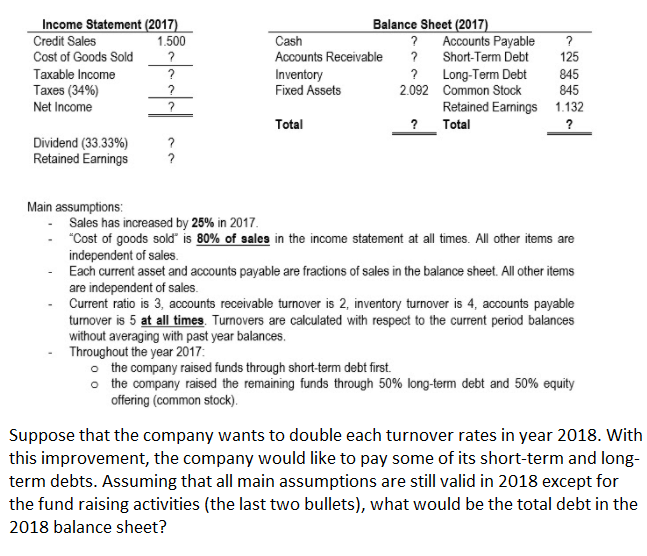Income Statement (2017) 1.500 Balance Sheet (2017) Accounts Payable ? Short-Term Debt ? Long-Term Debt 2.092 Common Stock Retained Earnings 1.132 Total Credit Sales Cash Accounts Receivable Inventory Fixed Assets Cost of Goods Sold 125 Taxable Income ? 845 845 Taxes (34%) Net Income Total ? Dividend (33.33%) Retained Earnings Main assumptions: Sales has increased by 25% in 2017. "Cost of goods sold" is 80% of sales in the income statement at all times. All other items are independent of sales. Each current asset and accounts payable are fractions of sales in the balance sheet. All other items are independent of sales. Current ratio is 3, acoounts receivable turnover is 2, inventory turnover is 4, accounts payable turnover is 5 at all times. Turnovers are calculated with respect to the current period balances without averaging with past year balances. Throughout the year 2017: o the company raised funds through short-term debt first. o the company raised the remaining funds through 50% long-term debt and 50% equity offering (common stock). Suppose that the company wants to double each turnover rates in year 2018. With this improvement, the company would like to pay some of its short-term and long- term debts. Assuming that all main assumptions are still valid in 2018 except for the fund raising activities (the last two bullets), what would be the total debt in the 2018 balance sheet?
Income Statement (2017) 1.500 Balance Sheet (2017) Accounts Payable ? Short-Term Debt ? Long-Term Debt 2.092 Common Stock Retained Earnings 1.132 Total Credit Sales Cash Accounts Receivable Inventory Fixed Assets Cost of Goods Sold 125 Taxable Income ? 845 845 Taxes (34%) Net Income Total ? Dividend (33.33%) Retained Earnings Main assumptions: Sales has increased by 25% in 2017. "Cost of goods sold" is 80% of sales in the income statement at all times. All other items are independent of sales. Each current asset and accounts payable are fractions of sales in the balance sheet. All other items are independent of sales. Current ratio is 3, acoounts receivable turnover is 2, inventory turnover is 4, accounts payable turnover is 5 at all times. Turnovers are calculated with respect to the current period balances without averaging with past year balances. Throughout the year 2017: o the company raised funds through short-term debt first. o the company raised the remaining funds through 50% long-term debt and 50% equity offering (common stock). Suppose that the company wants to double each turnover rates in year 2018. With this improvement, the company would like to pay some of its short-term and long- term debts. Assuming that all main assumptions are still valid in 2018 except for the fund raising activities (the last two bullets), what would be the total debt in the 2018 balance sheet?
College Accounting, Chapters 1-27
23rd Edition
ISBN:9781337794756
Author:HEINTZ, James A.
Publisher:HEINTZ, James A.
Chapter15: Financial Statements And Year-end Accounting For A Merchandising Business
Section: Chapter Questions
Problem 4SEA: FINANCIAL RATIOS Based on the financial statements for Jackson Enterprises (income statement,...
Related questions
Question

Transcribed Image Text:Income Statement (2017)
Credit Sales
Cost of Goods Sold
Balance Sheet (2017)
1.500
Cash
?
Accounts Payable
?
Accounts Receivable
Short-Term Debt
125
Long-Term Debt
2.092 Common Stock
Retained Earnings 1.132
Taxable Income
Inventory
Fixed Assets
?
845
Taxes (34%)
Net Income
845
Total
?
Total
?
Dividend (33.33%)
Retained Earnings
?
Main assumptions:
Sales has increased by 25% in 2017.
"Cost of goods sold is 80% of sales in the income statement at all times. All other items are
independent of sales.
Each current asset and accounts payable are fractions of sales in the balance sheet. All other items
are independent of sales.
Current ratio is 3, accounts receivable turnover is 2, inventory turnover is 4, accounts payable
turnover is 5 at all times. Turnovers are calculated with respect to the current period balances
without averaging with past year balances.
Throughout the year 2017:
o the company raised funds through short-term debt first.
o the company raised the remaining funds through 50% long-term debt and 50% equity
offering (common stock).
Suppose that the company wants to double each turnover rates in year 2018. With
this improvement, the company would like to pay some of its short-term and long-
term debts. Assuming that all main assumptions are still valid in 2018 except for
the fund raising activities (the last two bullets), what would be the total debt in the
2018 balance sheet?
Expert Solution
This question has been solved!
Explore an expertly crafted, step-by-step solution for a thorough understanding of key concepts.
Step by step
Solved in 4 steps

Knowledge Booster
Learn more about
Need a deep-dive on the concept behind this application? Look no further. Learn more about this topic, accounting and related others by exploring similar questions and additional content below.Recommended textbooks for you

College Accounting, Chapters 1-27
Accounting
ISBN:
9781337794756
Author:
HEINTZ, James A.
Publisher:
Cengage Learning,

College Accounting, Chapters 1-27 (New in Account…
Accounting
ISBN:
9781305666160
Author:
James A. Heintz, Robert W. Parry
Publisher:
Cengage Learning

Financial Accounting: The Impact on Decision Make…
Accounting
ISBN:
9781305654174
Author:
Gary A. Porter, Curtis L. Norton
Publisher:
Cengage Learning

College Accounting, Chapters 1-27
Accounting
ISBN:
9781337794756
Author:
HEINTZ, James A.
Publisher:
Cengage Learning,

College Accounting, Chapters 1-27 (New in Account…
Accounting
ISBN:
9781305666160
Author:
James A. Heintz, Robert W. Parry
Publisher:
Cengage Learning

Financial Accounting: The Impact on Decision Make…
Accounting
ISBN:
9781305654174
Author:
Gary A. Porter, Curtis L. Norton
Publisher:
Cengage Learning

Principles of Accounting Volume 1
Accounting
ISBN:
9781947172685
Author:
OpenStax
Publisher:
OpenStax College

Intermediate Accounting: Reporting And Analysis
Accounting
ISBN:
9781337788281
Author:
James M. Wahlen, Jefferson P. Jones, Donald Pagach
Publisher:
Cengage Learning

Financial Accounting
Accounting
ISBN:
9781337272124
Author:
Carl Warren, James M. Reeve, Jonathan Duchac
Publisher:
Cengage Learning